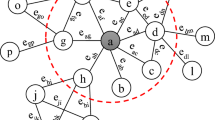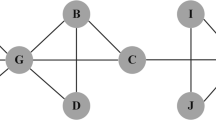Abstract
Evaluating and measuring key nodes in highly populated networks is essential to control the spreading effects of diseases or rumors. Although several incentive approaches have been proposed in complex networks to identify key nodes, these approaches still have many challenges. Most of the existing approaches consider just a single aspect of a node in a network. To cope with these challenges, based on the escape velocity formula, we propose Escape Velocity Centrality (EVC) approach to combine the concerned features of the network (i.e., local and global features) to measure key nodes in complex networks with spreading dynamics. Furthermore, we design an extended version of EVC (i.e., EVC+) to enhance the overall performance. To evaluate the effectiveness of EVC & EVC+, we implemented the proposed model via real-world as well as artificial networks. The empirical results based on susceptible–infected–recovered (SIR) and Kendall's correlation evaluation modelshave demonstrated that EVC & EVC+ outperformed the state-of-the-art centralities with remarkable margins of improvements with respect to all of the facets of evaluation.










Similar content being viewed by others
References
Li H, Zhang R, Zhao Z, Liu X, Yuan Y (2021) Identification of top-k influential nodes based on discrete crow search algorithm optimization for influence maximization. Appl Intell:1–17
Mnasri W, Azaouzi M, Romdhane LB (2021) Parallel social behavior-based algorithm for identification of influential users in social network. Appl Intell:1–19
Bahadori S, Moradi P, Zare H (2021) An improved limited random walk approach for identification of overlapping communities in complex networks. Appl Intell 51:3561–3580
Qiu L, Zhang J, Tian X (2021) Ranking influential nodes in complex networks based on local and global structures. Appl Intell:1–14
Tidke B, Mehta R, Dhanani J (2020) Consensus-based aggregation for identification and ranking of top-k influential nodes. Neural Comput Appl 32:10275–10301
Li D, Wang X, Huang P (2017) A fractal growth model: exploring the connection pattern of hubs in complex networks. Physica A: Stat Mech its Appl 471:200–211 URL https://www.sciencedirect.com/science/article/pii/S0378437116310184
Zhao J-H, Zeng D-L, Qin J-T, Si H-M, Liu X-F (2021) Simulation and modeling of microblog-based spread of public opinions on emergencies. Neural Comput Applic 33:547–564
Parastvand H, Chapman A, Bass O, Lachowicz S (2021) Graph automorphic approaches to the robustness of complex networks. Control Eng Pract 108:104705
Ren T et al (2020) Identifying vital nodes based on reverse greedy method. Sci Rep 10:1–8
Boccaletti S, Latora V, Moreno Y, Chavez M, Hwang D (2006) Complex networks: Struct Dynam Phys reports. 424
Yan Y, Qian Y, Sharif H, Tipper D (2012) A survey on smart grid communication infrastructures: motivations, requirements and challenges. IEEE Commun Surv Tutor 15:5–20
Faloutsos, M., Faloutsos, P. & Faloutsos, C. On power-law relationships of the internet topology. In The Structure and Dynamics of Networks, 195–206 Princeton University Press, (2011)
Kai-Quan C, Jun Z, Wen-Bo D, Xian-Bin C (2012) Analysis of the chinese air route network as a complex network. Chin Physics B 21:028903
Garlaschelli D, Caldarelli G, Pietronero L (2003) Universal scaling relations in food webs. Nature 423:165–168
Cui Y, Wang X, Li J (2014) Detecting overlapping communities in networks using the maximal sub-graph and the clustering coefficient. Physica A: Stat Mech Appl, URL 405:85–91 https://www.sciencedirect.com/science/article/pii/S0378437114002222
Milo R, Itzkovitz S, Kashtan N, Chklovskii D, Shen-Orr S, Alon U (2002) Network motifs: simple building blocks of complex networks. Science 298:824
Amancio D et al (2011) Using metrics from complex networks to evaluate machine translation. Physica A: Stat Mech Appl 390:131–142
Sheng J et al (2019) Community detection based on human social behavior. Physica A: Stat Mech Appl 531:121765
Estrada, E. Introduction to complex networks: structure and dynamics. In Evolutionary equations with applications in natural sciences, 93–131 Springer, (2015)
Sheng J et al (2019) FluidC+: a novel community detection algorithm based on fluid propagation. Int J Modern Physics C 30.04:1950021
Wang X, Zhao T, Qin X (2016) Model of epidemic control based on quarantine and message delivery. Physica A: Stat Mech Appl 458:168–178
Wang X, Zhao T (2017) Model for multi-messages spreading over complex networks considering the relationship between messages. Commun Nonlinear Sci Numer Simul 48:63–69
Li J, Wang X, Eustace J (2013) Detecting overlapping communities by seed community in weighted complex networks. Physica A: Stat Mech Appl 392:6125–6134
Song C, Havlin S, Makse HA (2005) Self-similarity of complex networks. Nature 433:392–395
Zhang Q, Li M, Deng Y (2018) Measure the structure similarity of nodes in complex networks based on relative entropy. Physica A: Stat Mech Appl 491:749–763
Wang XF (2002) Complex networks: topology, dynamics and synchronization. Int J Bifurcation Chaos 12:885–916
Bian T, Deng Y (2017) A new evidential methodology of identifying influential nodes in complex networks. Chaos, Solitons & Fractals 103:101–110
Barthelemy M (2004) Betweenness centrality in large complex networks. Eur Phys J B 38:163–168
Page L, Brin S, Motwani R, Winograd T (1999) The pagerank citation ranking: bringing order to the web. Tech. Rep, Stanford InfoLab
Brin S & Page L (1998) The anatomy of a large-scale hypertextual web search engine
Simsek A (2021) Lexical sorting centrality to distinguish spreading abilities of nodes in complex networks under the susceptible- infectious-recovered (sir) model. arXiv preprint arXiv:2101.10975
Ibnoulouafi A, El Haziti M (2018) Density centrality: identifying influential nodes based on area density formula. Chaos, Solitons Fractals 114:69–80
Zekun W, Xiangxi W, Minggong W (2019) Identification of key nodes in aircraft state network based on complex network theory. IEEE Access 7:60957–60967
Liu B, Li Z, Chen X, Huang Y, Liu X (2017) Recognition and vulnerability analysis of key nodes in power grid based on complex network centrality. IEEE Trans Circ Syst II: Express Briefs 65:346–350
Tulu MM, Hou R, Younas T (2018) Identifying influential nodes based on community structure to speed up the dissemination of information in complex network. IEEE Access 6:7390–7401
Wang Q et al (2018) Cda: a clustering degree based influential spreader identification algorithm in weighted complex network. IEEE Access 6:19550–19559Wang, Q.et al Cda: a clustering degree based influential spreader identification algorithm in weighted complex network. IEEE Access 6, 19550–19559 (2018)
Bonacich P (1972) Factoring and weighting approaches to status scores and clique identification. J Math Sociol 2:113–120
Freeman LC (1977) A set of measures of centrality based on betweenness. Sociometry:35–41
Freeman LC (1978) Centrality in social networks conceptual clarification. Soc Networks 1:215–239
Liu J, Xiong Q, Shi W, Shi X, Wang K (2016) Evaluating the importance of nodes in complex networks. Physica A: Stat Mech Appl 452:209–219
Kitsak M, Gallos LK, Havlin S, Liljeros F, Muchnik L, Stanley HE, Makse HA (2010) Identification of influential spreaders in complex networks. Nat Phys 6:888–893
Lancichinetti A, Fortunato S, Radicchi F (2008) Benchmark graphs for testing community detection algorithms. Phys Rev E 78:046110
Bian T, Deng Y (2018) Identifying influential nodes in complex networks: a node information dimension approach. Chaos: Interdiscipl J Nonlinear Sci 28:043109
Liu F, Wang Z, Deng Y (2020) Gmm: a generalized mechanics model for identifying the importance of nodes in complex networks. Knowl-Based Syst 193:105464
Fei L, Zhang Q, Deng Y (2018) Identifying influential nodes in complex networks based on the inverse-square law. Physica A: Stat Mech Appl 512:1044–1059
Zeng A, Zhang C-J (2013) Ranking spreaders by decomposing complex networks. Phys Lett A 377:1031–1035
Estrada E, Rodríguez-Velázquez JA (2005) Subgraph centrality in complex networks. Phys Rev E 71:056103
Freeman LC (1977) A set of measures of centrality based on betweenness. Sociometry:35–41
Ma L-L, Ma C, Zhang H-F, Wang B-H (2016) Identifying influential spreaders in complex networks based on gravity formula. Physica A: Stat Mech Appl 451:205–212
Ullah A, Wang B, Sheng JF, Long J, Khan N, Sun ZJ (2021) Identifying vital nodes from local and global perspectives in complex networks. Expert Syst Appl 186:115778
Aman U et al (2021) Identification of nodes influence based on global structure model in complex networks. Scientific Reports 11:1–11
Ullah A, Sheng J, Long J, Khan N et al (2021) Identification of influential nodes via effective distance-based centrality mechanism in complex networks. Complexity 2021:1–16
Dai J, Wang B, Sheng J, Sun Z, Khawaja FR, Ullah A, Dejene DA, Duan G (2019) Identifying influential nodes in complex networks based on local neighbor contribution. IEEE Access 7:131719–131731
Zareie A, Sheikhahmadi A, Jalili M, Fasaei MSK (2020) Finding influential nodes in social networks based on neighborhood correlation coefficient. Knowledge-Based Syst:105580
Zhong J, Zhang F, Li Z (2018) Identification of vital nodes in complex network via belief propagation and node reinsertion. IEEE Access 6:29200–29210
Zareie A, Sheikhahmadi A, Jalili M (2020) Identification of influential users in social network using gray wolf optimization algorithm. Expert Syst Appl 142:112971
Sun Z, Wang B, Sheng J, Hu Y, Wang Y, Shao J (2017) Identifying influential nodes in complex networks based on weighted formal concept analysis. IEEE Access 5:3777–3789
Qiao T, Shan W, Yu G, Liu C (2018) A novel entropy-based centrality approach for identifying vital nodes in weighted networks. Entropy 20:261
Zareie A, Sheikhahmadi A, Jalili M (2019) Identification of influential users in social networks based on users' interest. Inform Sci 493:217–231
Maji G, Namtirtha A, Dutta A, Malta MC (2020) Influential spreaders identification in complex networks with improved k-shell hybrid method. Expert Syst Appl 144:113092
Li Z et al (2019) Identifying influential spreaders by gravity model. Sci Rep 9:1–7
Güvenc U, Katırcıoǧlu F (2019) Escape velocity: a new operator for gravitational search algorithm. Neural Comput & Applic 31:27–42
Guimer R, Danon L, Daz-Guilera A, Giralt FA (2003) Arenas, Self-similar community structure in a network of human interactions. Phys. Rev. E 6:8065103
Federal Aviation Administration, Air traffic control system command center, http://www.fly.faa.gov/, (2017)
Cohen W Enron email dataset, URL: http://www.cs.cmu.edu/~enron/. Accessed in (2009)
SocioPatterns, Infectious contact networks,????URL: http://www. sociopatterns.org/datasets/
Allen L (1994) J. some discrete-time si, sir, and sis epidemic models. Math Biosci 124:83–105
Keeling MJ, Eames KT (2005) Networks and epidemic models. J R Soc Interface 2:295–307
Kendall MG (1945) The treatment of ties in ranking problems. Biometrika 33:239–251
Acknowledgments
This work was supported by the National Key Research and Development Program of China under Grant no. 2018YFB1003602.
Author information
Authors and Affiliations
Corresponding author
Additional information
Publisher’s note
Springer Nature remains neutral with regard to jurisdictional claims in published maps and institutional affiliations.
Rights and permissions
About this article
Cite this article
Ullah, A., Wang, B., Sheng, J. et al. Escape velocity centrality: escape influence-based key nodes identification in complex networks. Appl Intell 52, 16586–16604 (2022). https://doi.org/10.1007/s10489-022-03262-4
Accepted:
Published:
Issue Date:
DOI: https://doi.org/10.1007/s10489-022-03262-4




